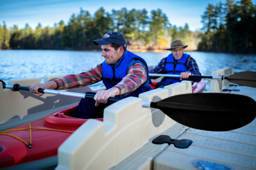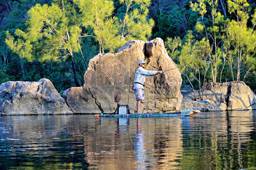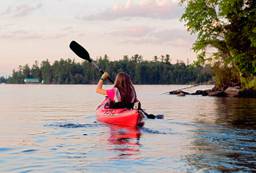

You’re all set for an extended paddling trip with your family. You’ve packed a cooler full of food, grabbed the sleeping bags and tent in case you decide to make it an overnight, and even brought along extra food for the dog. Then you remember you own a one-seat kayak built for playing around the dock.
If only you had these tips to help you choose the right kayak or canoe for your cabin, you wouldn’t be stuck with a dog on your lap and your family gazing longingly at the water from the shore as you paddle away.
Tip#1: Materials
Kayaks and canoes made of plastic or polyethylene are the toughest and most UV, rock and weather–resistant. But if you pulled a composite craft (a very lightweight combination of fiberglass cloth, resin, and materials like kevlar and carbon) up on the rocks, you’d punch a hole in it. Thermoformed kayaks and canoes are not quite as fragile as composite, but are still too fragile for dragging.
See also How to Keep Your Dog Safe During the Summer Heat
Tip#2: Storage
If you have a boathouse with mechanical launch or a wheeled cart plus ramp to the water for launching you can store any kayak or canoe. If you store your craft in a garage or under your deck, remember that it’s happiest stored off the ground on its side on wall mounted j-hooks or in slings that cradle the hull. Ultraviolet rays from the sun age and fade all boats, so whatever your choice, keep your craft covered, inside or in the shade when it’s not in use. If storage space is at a premium, an inflatable craft can be an excellent choice. Inflatables are available across the same performance categories and price ranges as those made of wood, plastic, or composite.
Tip#3: Use
Generally, canoes are better suited to extended trips, as they have greater room for storage. Paddlers who spend the bulk of their time in ocean and river waters that are choppy or windy, however, tend to prefer kayaks. But advancements in kayak and canoe design have further blurred the lines of distinction between the crafts. Here, then, are some important factors to consider when choosing the right craft for you.
If you only paddle out for picnics or play around the swim dock, either a canoe or a sit-on-top kayak will be fine. A sit-on-top kayak will get you wet, but in mild weather on calm waters, it shouldn’t be too much of an issue. If a canoe seems more your style, make sure it has ample storage space for the picnic baskets, the sunblock – and the dog. If you want a kayak but plan on using it for full day or overnight outings in lake, ocean or river water that could be choppy, steer yourself toward a kayak that is fast and efficient, with enough storage to hold your gear. And choose a kayak with excellent secondary stability (secondary stability means that the boat won’t tip easily, whereas primary stability means that the boat merely feels stable).
You may also want to consider a kayak with a rudder or skeg for best tracking and steerability. If the water where you’re paddling is cold, make sure your kayak can accommodate a spray skirt, which will keep you dry inside your craft. If you want to brave rough waters in a canoe, however, pay special attention to the hull. It will either be designed for the flat, open water most commonly found in a lake, or for the swift water of a fast moving river. Also, size matters: a bigger boat will go faster, but will be more cumbersome to launch and handle.
Tip#4: Special Crafts
Paddling is a popular sport among everyone from Arctic adventurers to triathletes to fishermen to families. The fitness-minded should consider a canoe or kayak that is light and trim, tracks well and is designed for high aerobic output. Often made of more expensive materials like composites or thermoformed plastic, these crafts are more prone to wear and tear. A craft in the splash-around category will typically be less fragile, but also heavier and less efficient.
If you’re a fisherman, your choices include canoes and kayaks outfitted with everything from basic rod holders to anchor attachments and fishfinders. If you’re interested in a family outing, but want a kayak, you might investigate tandems. Some high-end tandems have dual distinct cockpits, but on the lower price end, there are kayaks that can accommodate two paddlers plus a child or two (or even a well-behaved dog) – all in one cockpit with flexible seating.
See also How to Get Out on the Water and Love it
Tip#5: Price
Recreational canoes and kayaks tend to be made from plastic. These craft are the least expensive and are the most resistant to wear and tear, but offer the lowest performance. Day-trippers can be made from any material – the price increases as you move from polyethylene to thermoformed to composite, and can range anywhere from several hundred to several thousand dollars. Touring/expedition boats range in materials from polyethylene to composite, and some high-end boats are even made from wood. These craft can easily cost over $1,000 and usually offer more outfitting and customization options, though fishing rigs are available in a wide range of prices.
See also Barefoot Waterski Products to Keep You Warm
Tip#6: Test-Paddle
Whatever you buy, sit in it first, even if it’s just in the showroom. Make sure that it’s comfortable for you, from the cockpit opening in a kayak (you should be able to get in and out easily), to the seats in a canoe (they should be comfortable and wide), to the width of the craft (you shouldn’t feel like you’re swimming in it). Whether you choose a roughwater kayak, a lazy-day canoe, or any of the other countless variations, use these tips and you’ll spend many happy hours on the water.
When Berne Broudy is not testing paddling and other gear for leading outdoor publications, she is taking photos and finishing up house projects with her husband Mike.










